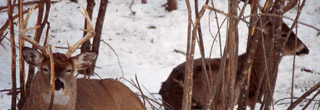Very fresh, ¾-inch-long droppings enabled author’s son, Ken, to take this buck on opening morning.
Note — originally — this blogpost was published a month or two ago — but for some reason it has dropped off of my blog — so I am posting it a second time.
Very fresh tracks of unalarmed whitetails are not only the most rewarding of deer signs, but they enable the hunter to regularly key on specific classes of deer — mature bucks, for example. The trouble is, they can be difficult to find. A lack of snow, dry or frozen ground or falling leaves are notable reasons.
Clumped buck droppings — hard, dry, dull — not fresh. When you see clumped droppings — think, “buck sign” — then measure the droppings to approximate the class of buck. Clumping is a sign of the stresses the buck is going through.
Second best are fresh deer droppings (scats). “Fresh” means shiny and soft with no frost crystals on them in sub-freezing temperatures. Beginning in September, droppings of antlered bucks are commonly clumped (stuck together). Doe droppings remain separate. Whereas one set of droppings can contain a few larger and smaller droppings than most and sizes of droppings from individual deer can vary a bit with diet, for the most part the more common lengths (not including the little knobs at the ends) in a puddle or clump of droppings nonetheless provide two bits of information that can greatly improve odds of hunting success: 1) the class of deer that made the droppings and 2) the vicinity, trail or site currently frequented by that deer, meaning, it is likely to be seen in that same vicinity, on that same trail or at that same site within a few hours, later the same day or the following morning (don’t count on it after that). Very fresh droppings discovered in the vicinity of a current favorite whitetail feeding area (sites characterized by greater numbers of off-trail droppings, fresh and old) are the most rewarding.

From a trophy-class buck that we didn’t get in 2016.
(Unclumped, found while scouting, before stresses of breeding.) We absolutely love to find droppings like this when we do our final fall scouting — about 2 weeks before the season opener.

From another trophy-class buck that we didn’t get in 2016. (Unclumped, found while scouting, before stresses of breeding.) Notice this detail: while the droppings of both of these trophy-class bucks were large, on average, they had distinctly different sized & shaped droppings.
In northern Minnesota where I hunt and study whitetails, mature does (two or more years of age) and yearling bucks have droppings measuring one-half inch in length. Droppings of fawns and yearling does are shorter. All longer droppings are those of mature bucks (two or more years of age). In fall, droppings measuring ¾ to 1-1/4 inches in length are those of bucks 3-1/2 to 6-1/2 years of age (considered “trophy-class” by most hunters).

